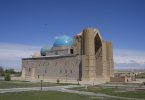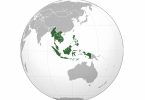(eTN) – The Zambezi Society is disappointed to report that construction has begun on one of the controversial new 48-bed “lodge” developments along the Zambezi River shoreline in Mana Pools National Park, which is a UNESCO World Heritage Site and a Core Area of the recently-declared UNESCO Middle Zambezi Biosphere Reserve. This, despite recommendations against such development in the recent Park Management Plan, which cites potential damage to the fragile riverine eco-system at Mana Pools, which is already stressed by tourism impact.
A lease for the proposed 48-bed (plus 24 staff) “Mana Pools Safari Camp” with a 1-km exclusion zone centered on the Vine Camp Site (about 15 kms upstream from the park headquarters in Nyamepi) was granted to ECIS Investments (Ms. Li Song) by the Zimbabwe Parks and Wildlife Management and signed by the Minster of the Environment in September 2010. An EIA was completed in June 2011 by Vibes Consultancy, and was approved by the Environmental Management Agency (EMA) shortly thereafter.
The EIA describes this as a “semi-permanent” camp with 12 thatched double chalets on raised metal and wood platforms above the Zambezi River floodplain, a large, thatched living/dining/bar area, a brick-under-tin-roof kitchen/workshop/garage/storeroom complex, a vast (280 sq m) brick-under-tin quarters for 24 staff, a fence, a swimming pool, 14 septic tanks, and a cold-room – all of this powered by a “solar-system with a back-up generator.”
The Vine Camp Site area contains one of the park’s prime examples of magnificent alluvial woodland covering the banks of the Zambezi River. Within this precious woodland are vast specimens of very ancient Zambezi fig trees, Natal Mahoganies and River Litchis, rare climbing lianes, such as the beautiful “Tail-less Tailflower” and other species special to the Zambezi “alluvial floodplain.” The woodland is a favored spot for a host of wildlife species, including elephant and the predators that Mana Pools is so famous for: lions, leopards, and wild dogs.
This EIA was approved by Zimbabwe’s Environmental Management Agency (EMA) without wide consultation. Important and informed stakeholders from Zambia, UNESCO, the Zimbabwean Department of Museums and Monuments, and relevant NGOs, including the Zambezi Society, were not informed or consulted during the process.
The Zambezi Society obtained a copy of the EIA only after it had already been approved. It was found to be inadequate, inaccurate, and ill-informed. Environmental experts were consulted, including the Chairman of the UNESCO Mana and Biosphere Committee in Zimbabwe, and the Society obtained their critical reviews of this document. In March 2012, these were submitted, with the Zambezi Society’s own formal objection to the EIA, to the Environmental Management Agency, and copied to relevant authorities in National Parks and UNESCO. The letter stated:
“We ask that EMA consider these comments seriously, in the light of our sincere concern for the future of the wildlife and wilderness resources of Mana Pools. We urge you to reconsider your approval of this EIA and ask that a more professional and detailed assessment be undertaken, with wider public consultation, in view of the global significance of Mana Pools. We also request that, should the EIA be re-submitted, those parties copied in this letter be given the opportunity to evaluate the EIA prior to it being authorized.
“The Zambezi Society is ready and willing to assist in this process in order to achieve a solution which will sufficiently protect the biological value of Mana Pools, while allowing economic benefit from tourism development in the park.”
To this date, there has been no response from EMA.
The Society then wrote similarly to the Minister of the Environment and, to this date, there has been no response.
In June 2012, The Zambezi Society met with the head of the National Committee of UNESCO in Zimbabwe to brief him about this situation along with colleagues from the Department of Museums and Monuments who, themselves had not been consulted during the EIA process for this development. They have agreed to undertake a “high level” visit to the construction site as soon as possible to assess the situation for themselves.
In the meantime, the Society is liaising with colleagues in Zambia to advise them of the situation and to see what assistance they may be able to provide.






















